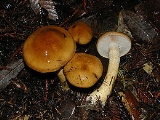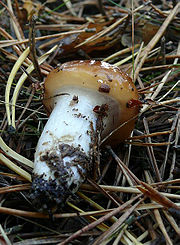
Cortinarius mucosus
Encyclopedia
Cortinarius mucosus, commonly known as the orange webcap or the slimy cortinarius, is a species
of mushroom
in the family
Cortinariaceae
. In North America
, the species is more commonly associated with northern coniferous forests. The specific epithet is derived from the Latin word mucosus, meaning mucus.
in 1792, Cortinarius mucosus belongs to the subgenus Myxacium (characterized by the presence of a viscid to glutinous outer veil and stipe), section Myxacium (distinguished by the presence of clamp connection
s), according to the infrageneric classification of the Cortinarius
genus proposed by Moser in Singer (1986).
 The species has a sticky brown to orange cap
The species has a sticky brown to orange cap
, 4 to 10 cm (1½ to 4 in) in diameter, that is darker towards the center and with a rolled-in margin. The gills are closely spaced, have an adnexed attachment to the stipe
, and are pale yellowish at first, becoming rusty brown as the spores mature. Like all species in the genus Cortinarius
, young specimens have a cortina, a cobweb-like annulus
that protects the developing gills. The slimy stipe, 5 to 15 cm (2 to 5.9 in) long by 1.5 to 2.5 cm (0.590551181102362 to 0.984251968503937 in) thick, is whitish until the spores mature and begin falling. The spore print
is rust- to ochre-colored. Both the odor and the taste of this mushroom are nondescript.
The spore
s have a rough surface, and an elliptical shape, with dimensions of 12–14 x 5.5–6.5 µm
. The basidia are 4-spored, and cystidia are not present on the edge of the gills.
The species is commonly found under birch
and coniferous trees. It prefers acidic, sandy soils.
genus, and the difficulty of positively identifying specimens to species level, consumption of any Cortinarius species is not generally recommended. Also, specimens of C. mucosus collected from northern Poland
were found to bioaccumulate
high concentrations of the toxic element mercury
—that is, the concentration of mercury in the mature mushroom was significantly higher than that of the soil in which it grew.
Species
In biology, a species is one of the basic units of biological classification and a taxonomic rank. A species is often defined as a group of organisms capable of interbreeding and producing fertile offspring. While in many cases this definition is adequate, more precise or differing measures are...
of mushroom
Mushroom
A mushroom is the fleshy, spore-bearing fruiting body of a fungus, typically produced above ground on soil or on its food source. The standard for the name "mushroom" is the cultivated white button mushroom, Agaricus bisporus; hence the word "mushroom" is most often applied to those fungi that...
in the family
Family (biology)
In biological classification, family is* a taxonomic rank. Other well-known ranks are life, domain, kingdom, phylum, class, order, genus, and species, with family fitting between order and genus. As for the other well-known ranks, there is the option of an immediately lower rank, indicated by the...
Cortinariaceae
Cortinariaceae
The Cortinariaceae are a large family of gilled mushrooms found worldwide, containing over 2100 species. The family takes its name from its largest genus, the varied species of the genus Cortinarius...
. In North America
North America
North America is a continent wholly within the Northern Hemisphere and almost wholly within the Western Hemisphere. It is also considered a northern subcontinent of the Americas...
, the species is more commonly associated with northern coniferous forests. The specific epithet is derived from the Latin word mucosus, meaning mucus.
Taxonomy
Originally described as Agaricus mucosus by French mycologist Pierre BulliardJean Baptiste François Pierre Bulliard
Jean Baptiste François Pierre Bulliard was a French physician and botanist....
in 1792, Cortinarius mucosus belongs to the subgenus Myxacium (characterized by the presence of a viscid to glutinous outer veil and stipe), section Myxacium (distinguished by the presence of clamp connection
Clamp connection
A clamp connection is a structure formed by growing hyphal cells of certain fungi. It is created to ensure each septum, or segment of hypha separated by crossed walls, receives a set of differing nuclei, which are obtained through mating of hyphae of differing sexual types...
s), according to the infrageneric classification of the Cortinarius
Cortinarius
Cortinarius is a genus of mushrooms. It is suspected to be the largest genus of agarics, containing over 2000 different species and found worldwide. A common feature among all species in the genus Cortinarius is that young specimens have a cortina between the cap and the stem, hence the name,...
genus proposed by Moser in Singer (1986).
Description

Pileus (mycology)
The pileus is the technical name for the cap, or cap-like part, of a basidiocarp or ascocarp that supports a spore-bearing surface, the hymenium. The hymenium may consist of lamellae, tubes, or teeth, on the underside of the pileus...
, 4 to 10 cm (1½ to 4 in) in diameter, that is darker towards the center and with a rolled-in margin. The gills are closely spaced, have an adnexed attachment to the stipe
Stipe (mycology)
thumb|150px|right|Diagram of a [[basidiomycete]] stipe with an [[annulus |annulus]] and [[volva |volva]]In mycology a stipe refers to the stem or stalk-like feature supporting the cap of a mushroom. Like all tissues of the mushroom other than the hymenium, the stipe is composed of sterile hyphal...
, and are pale yellowish at first, becoming rusty brown as the spores mature. Like all species in the genus Cortinarius
Cortinarius
Cortinarius is a genus of mushrooms. It is suspected to be the largest genus of agarics, containing over 2000 different species and found worldwide. A common feature among all species in the genus Cortinarius is that young specimens have a cortina between the cap and the stem, hence the name,...
, young specimens have a cortina, a cobweb-like annulus
Annulus (mycology)
An annulus is the ring like structure sometimes found on the stipe of some species of mushrooms. The annulus represents the remaining part of the partial veil, after it has ruptured to expose the gills or other spore-producing surface. An annulus may be thick and membranous, or it may be cobweb-like...
that protects the developing gills. The slimy stipe, 5 to 15 cm (2 to 5.9 in) long by 1.5 to 2.5 cm (0.590551181102362 to 0.984251968503937 in) thick, is whitish until the spores mature and begin falling. The spore print
Spore print
thumb|300px|right|Making a spore print of the mushroom Volvariella volvacea shown in composite: mushroom cap laid on white and dark paper; cap removed after 24 hours showing pinkish-tan spore print...
is rust- to ochre-colored. Both the odor and the taste of this mushroom are nondescript.
The spore
Spore
In biology, a spore is a reproductive structure that is adapted for dispersal and surviving for extended periods of time in unfavorable conditions. Spores form part of the life cycles of many bacteria, plants, algae, fungi and some protozoa. According to scientist Dr...
s have a rough surface, and an elliptical shape, with dimensions of 12–14 x 5.5–6.5 µm
Micrometre
A micrometer , is by definition 1×10-6 of a meter .In plain English, it means one-millionth of a meter . Its unit symbol in the International System of Units is μm...
. The basidia are 4-spored, and cystidia are not present on the edge of the gills.
The species is commonly found under birch
Birch
Birch is a tree or shrub of the genus Betula , in the family Betulaceae, closely related to the beech/oak family, Fagaceae. The Betula genus contains 30–60 known taxa...
and coniferous trees. It prefers acidic, sandy soils.
Edibility
Due to the prevalence of toxins in the CortinariusCortinarius
Cortinarius is a genus of mushrooms. It is suspected to be the largest genus of agarics, containing over 2000 different species and found worldwide. A common feature among all species in the genus Cortinarius is that young specimens have a cortina between the cap and the stem, hence the name,...
genus, and the difficulty of positively identifying specimens to species level, consumption of any Cortinarius species is not generally recommended. Also, specimens of C. mucosus collected from northern Poland
Poland
Poland , officially the Republic of Poland , is a country in Central Europe bordered by Germany to the west; the Czech Republic and Slovakia to the south; Ukraine, Belarus and Lithuania to the east; and the Baltic Sea and Kaliningrad Oblast, a Russian exclave, to the north...
were found to bioaccumulate
Bioaccumulation
Bioaccumulation refers to the accumulation of substances, such as pesticides, or other organic chemicals in an organism. Bioaccumulation occurs when an organism absorbs a toxic substance at a rate greater than that at which the substance is lost...
high concentrations of the toxic element mercury
Mercury (element)
Mercury is a chemical element with the symbol Hg and atomic number 80. It is also known as quicksilver or hydrargyrum...
—that is, the concentration of mercury in the mature mushroom was significantly higher than that of the soil in which it grew.

